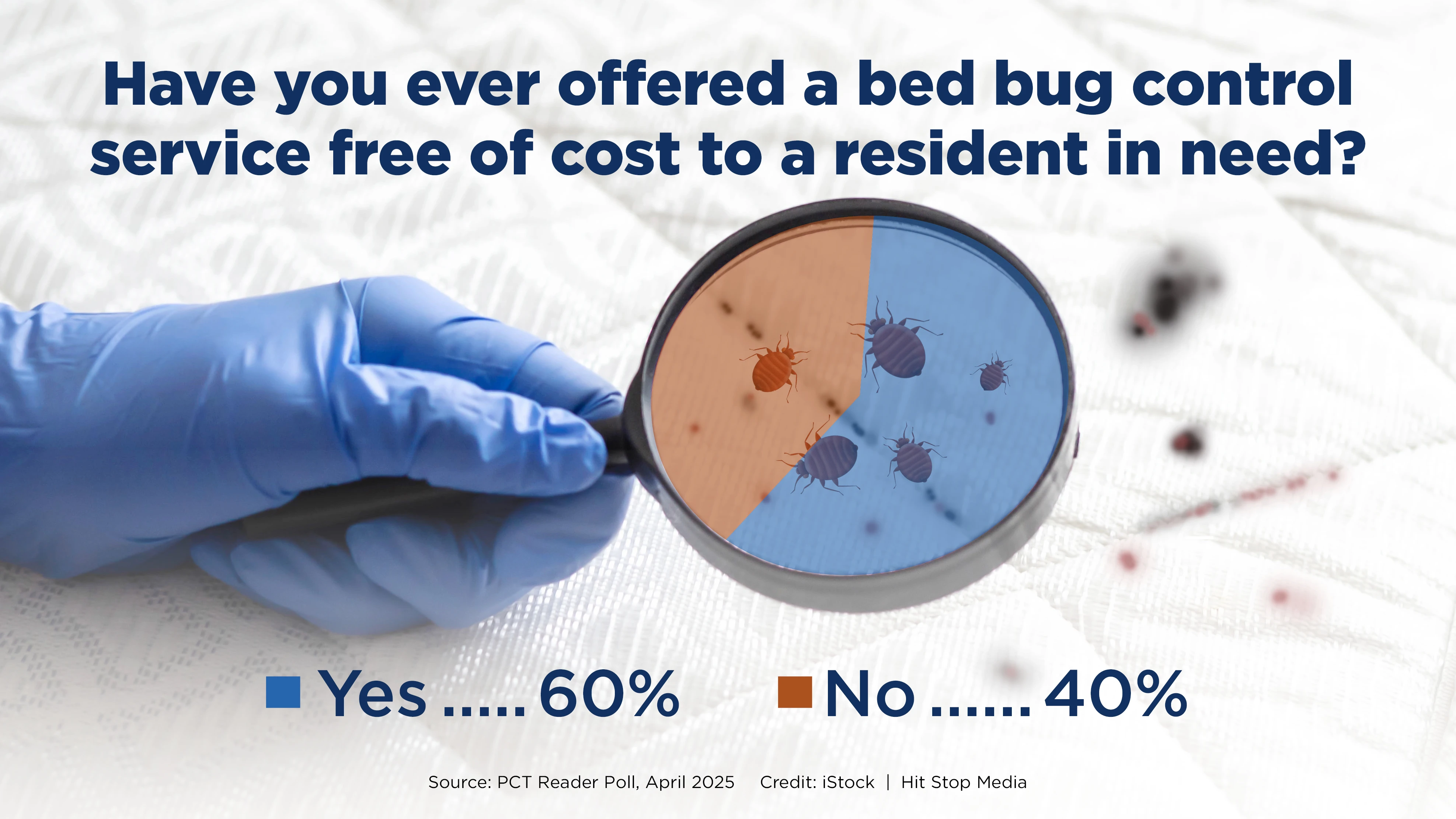By: Lynn Braband and John F. Organ
When structural pest management companies add wildlife control to their service offerings, they enter a world of new critters, equipment and techniques. Additionally, they encounter new governmental agencies. These organizations tend to have different histories and philosophies than the state agencies and the U.S. EPA, which regulate pesticide use. The purpose of this article is to explain the over-arching philosophy of those that regulate nuisance wildlife control activities and explore some of the implications of this philosophy.
State wildlife agencies and the U.S. Fish and Wildlife Service primarily regulate wildlife management and conservation, including control activities. Most of these employees have degrees in wildlife biology from state universities and are steeped in what has become known as the North American Model of Wildlife Conservation. This model characterizes wildlife as valuable resources that are to be managed for current and future generations. The Wildlife Society, the major professional organization of wildlife biologists, views the model as the bedrock of wildlife management in the U.S. and identifies seven main components of the model.
Wildlife is a public trust resource. Essentially this maintains wild animals are owned by the public not by the landowners of the properties where the animals live. This perspective is deeply rooted in our history as pioneers living off of the land, and contrasts with the centuries old European pattern of a relatively few large landowners owning wildlife on their property. The legal precedent for this Public Trust idea goes back to the ancient Greeks and Romans, and in the United States occurred quite early with a U.S. Supreme Court decision in 1842. Subsequent legal activities have established stewardship of the public ownership is entrusted primarily with the states. The federal government only has precedent over the states when wildlife are covered under one of three constitutional provisions: federal property (property clause), interstate commerce (commerce clause), or international treaty, such as the migratory bird treaty and the Convention on International Trade in Endangered Species (supremacy clause).
Elimination of markets for game. While our pioneer history resulted in a pattern of common use of wildlife, our forbearers were utilitarian. Wild animals were seen either as dangerous competitors or objects for short-term use. With the onset of the Industrial Revolution and increasing urban populace that needed to be fed, this resulted in a great decrease in the abundance of many species and culminated in the late 19th and early 20th centuries in market hunting, the large scale harvesting and shipment of wildlife as food to thriving urban markets. One of the first major battles, and successes, of wildlife conservation was the legal elimination of this practice.
Allocation of wildlife by law, rather than by privilege, birthright, or land ownership as was the pattern in many parts of Europe.
Wildlife should only be killed for a legitimate purpose. It used to be common practice to shoot wild animals just for the sake of shooting them. “Varmint” control may have been given as the reason. But it is hard to envision mass shooting of migrating hawks or nesting pelicans as anything but a big party.
Wildlife are an international resource. As in the United States, advocacy for wildlife conservation in Canada resulted in governmental protection at the provincial and federal levels. Collaborations between our two countries led to treaties concerning marine mammals and migratory birds. Partnership in these and other wildlife treaties have been expanded to Mexico, Europe, and other countries.
Science is the proper tool for discharge of wildlife policy. Throughout the 20th century and led by initiatives from the Roosevelt (both Teddy and Franklin) administrations, the role of science as the bedrock for wildlife management decisions was emphasized.
Democracy of hunting. Again the emphasis that use of wildlife is not limited to a privileged few. As an activity of the developing middle class during the 19th century, sport hunting promoted concepts of “fair play, self-restraint, pioneer skills, and health,” not survival or profit. “Conflicts between sport hunters and market hunters led to advocacy for the elimination of markets for game, allocation of wildlife by law rather than privilege, and restraint in killing wildlife.”
Although the North American Model is the historical and legal bedrock for our wildlife regulatory policies, it has challengers and critics. Recently several Texas landowners arguing that wildlife held captive by high fences should belong to the landowner, not the public, brought a lawsuit. The case was apparently dismissed for want of prosecution by the plaintiffs.
Some biologists argue that sport hunting can’t control “overabundant” species such as deer and geese. These individuals have advocated for highly regulated market hunting which would differ from the unregulated market hunting of a century ago. Others have described the difficulty of transferring the model to other cultures that are without an underlying cultural ethos and effective governmental infrastructure to implement it. Influential private large landowners with personal conservation ethics may be more important in these situations. Finally, many feel that the democracy of hunting element of the model is challenged by the widespread practice of leasing hunting rights on private land.
WHAT THIS MEANS. What are some of the implications for pest management professionals? Wildlife pest situations in and near structures usually involve one or a few animals. These individuals typically range more widely than the property being damaged. While experienced pest management professionals are good at troubleshooting individual pest situations, wildlife agencies tend to focus at the population level. For example, what is the potential impact (disease transmission, rate of aggressive encounters, etc.) of trapping, transporting and releasing raccoons on other raccoons?
Some wildlife control activities need to meet both federal and state regulations. This is especially true when dealing with legally defined migratory birds, such as Canada geese or woodpeckers. Also, wildlife agencies are reluctant to condone activities that may result in many wildlife species being thought of as primarily pests rather than valuable resources.
It has been argued that the North American Model is the most successful and effective wildlife management system in the world. In issuing regulations and permits, agency biologists are thinking not only about solving particular damage problems but how to maintain the legacy and heritage of stewardship of wildlife resources for the benefit of current and future generations of Americans. This may at times be frustrating to a pest management firm that is seeking to meet the immediate needs and desires of their customers.
To be successful, pest management professionals working with nuisance wildlife control need to understand and be willing to work with this paradigm, following established guidelines and regulations. If they have questions about dealing with wildlife issues, contact their state’s wildlife agency or university cooperative extension office. A comprehensive Web site is the Internet Center for Wildlife Damage Management http://icwdm.org/. Good resource books include “Best Practices for Wildlife Control Operators” by Paul D. Curtis and Jill Shultz (Thomson Delmar Learning) and the University of Nebraska’s “Prevention and Control of Wildlife Damage,” currently under revision.
Authors’ acknowledgements: John E. McDonald, U.S. Fish and Wildlife Service, and Laura Bies, The Wildlife Society, provided helpful input to this article’s content.
Braband is an extension educator with the New York State IPM Program of Cornell University. Organ is chief of Wildlife and Sport Fish Restoration for the U.S. Fish and Wildlife Service’s Northeast Region and adjunct associate professor of wildlife ecology, University of Massachusetts, Amherst.
*********************
Buffalo Exterminating’s Wildlife PR Success Story
Buffalo Exterminating, Orchard Park, N.Y., last year provided services free of charge to assist an area resident in solving a significant bat problem in her home. Buffalo Exterminating’s assistance offers a great example of a company utilizing its expertise to foster goodwill within the community while leveraging an opportunity for a strong public relations effort.
John Zimmerman, general manager of Buffalo Exterminating, said he saw a news story on WIVB-TV, Channel 4 in Buffalo, N.Y., detailing the plight of a Cattaraugus County woman who had hundreds of bats living under her roof. Located about 40 miles south of Buffalo, the home is in a rural area. Not sure how to address the bat problem, the homeowner turned to an investigative reporter at the TV station for help. When Zimmerman saw the story, he knew right away what needed to be done.
“This was such an extreme case, I could tell where the problems were just from seeing the report on TV,” he said. “There were hundreds of bats coming and going from around the roof line and the ridge caps. Other members of our team at Buffalo Exterminating also saw the report, and the next day at the office, we decided to offer our assistance.”
Buffalo Exterminating contacted the investigative reporter and made arrangements to provide service for the homeowner. Technicians went to work sealing entry points and installing one-way exits that let the bats out but do not allow them to get back in. While the work was in progress, TV cameras filmed the crew and Zimmerman was interviewed by the reporter. Several camera shots showed company trucks at the home and crew members wearing shirts with the Buffalo Exterminating logo, providing excellent publicity for the company.
The story closed with the reporter noting that the pest management company was providing the service for free, a job which in this case would normally cost $3,000 to $3,500. The homeowner expressed her appreciation on camera and the reporter concluded by explaining Buffalo Exterminating would return in a couple of weeks to check on the home. “First and foremost, we offered our services because it was the right thing to do,” Zimmerman said. “However, the media exposure we gained was beneficial, and in keeping with our community-minded public relations strategy.”
Zimmerman said following the TV report the firm received numerous phone calls from homeowners seeking free assistance. Buffalo Exterminating’s telephone representatives explained that the case featured on the news program was an exception. At the same time, the company estimates the TV feature resulted in more than a dozen new customers for bat-related work.
WANT MORE?
Enter your email to receive our newsletters.

Explore the September 2009 Issue
Check out more from this issue and find your next story to read.
Latest from Pest Control Technology
- Target Specialty Products, MGK Partner for Mosquito Webinar
- Cockroach Control and Asthma
- FORSHAW Announces Julie Fogg as Core Account Manager in Georgia, Tennessee
- Envu Introduces Two New Innovations to its Pest Management Portfolio
- Gov. Brian Kemp Proclaimed April as Pest Control Month
- Los Angeles Ranks No. 1 on Terminix's Annual List of Top Mosquito Cities
- Kwik Kill Pest Control's Neerland on PWIPM Involvement, Second-Generation PCO
- NPMA Announces Unlimited Job Postings for Members





